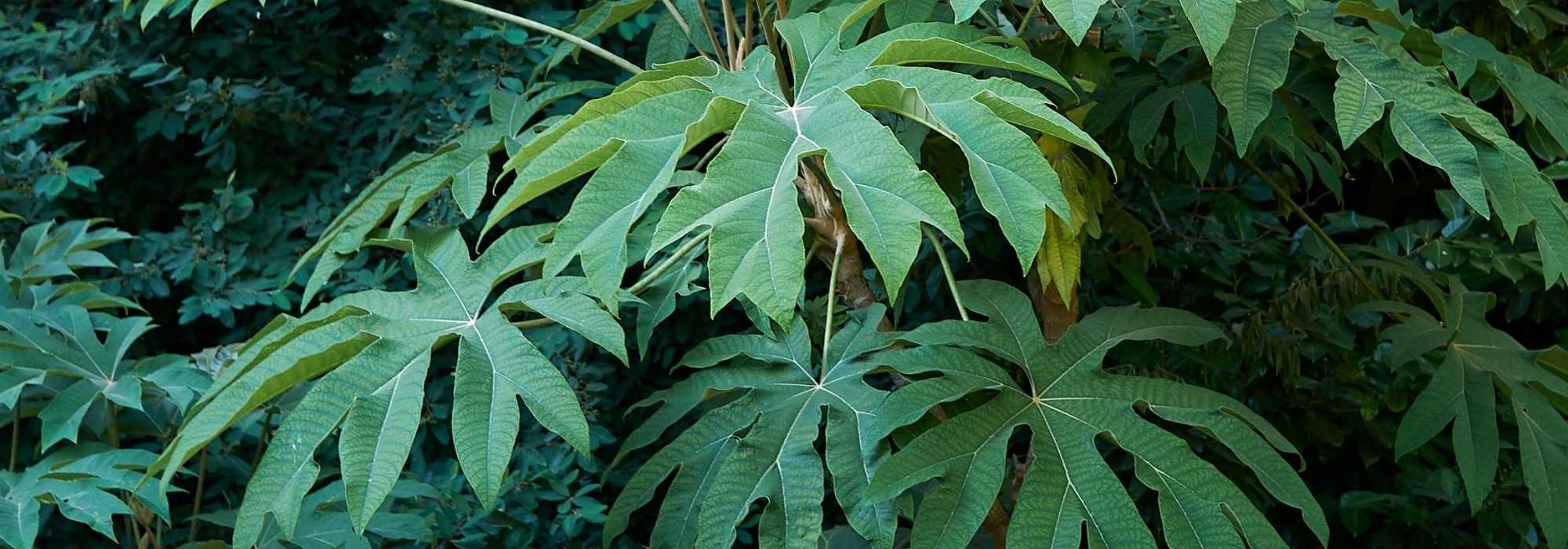
Tetrapanax, Rice Paper Tree: Planting, Cultivation, Maintenance
Contents
Tetrapanax in a nutshell
- Tetrapanax, or Rice Paper Tree, is a bush with a distinctly lush and exotic appearance.
- Its leaves, palmate and lobed, can reach gigantic dimensions.
- Fast-growing, easy to grow, and disease-free, it typically reaches 4m in height.
- Evergreen in mild climates, it is hardy down to about -12°C.
- A semi-shade bush, it prefers rich, cool, and well-drained soils.
- It is highly valued in the design of urban jungles, Japanese gardens, or contemporary landscapes.
The word from our expert
The Tetrapanax papyrifera is a bush that brings a distinctly exotic touch to landscaping. Fast-growing, it is easy to grow, has no enemies, and requires very little maintenance. Ultimately, depending on the growing conditions, it can reach between 4 and 6 m, and produces leaves of impressive dimensions. Palmate and deeply lobed, particularly in cultivars like ‘Rex’, they are green and pubescent, and more rarely variegated, as seen in the variety ‘Variegata’. Commonly known as the Rice Paper Tree, its powerful roots can spread, the plant then producing suckers, sometimes forming true little thickets worthy of a tropical jungle. With average hardiness, its foliage is deciduous at -5°C, but the plant can withstand short frosts of around -10°C, or even slightly harsher conditions. Preferring warm and humid environments, it thrives ideally in partial shade, in rich, loose, fertile soil that remains cool in summer, without retaining water in winter. Highly valued in Japanese-style gardens, it enhances the lushness of exotic settings, and its striking form also makes it suitable for contemporary gardens. Capable of being very vigorous in the ground, it can also be grown in a large pot to decorate a balcony, terrace, or patio sheltered from the wind, which can damage its foliage. Under optimal conditions, it can flower in late summer, producing panicles of small cream-white flowers, whose ornamental appeal is not universally appreciated.
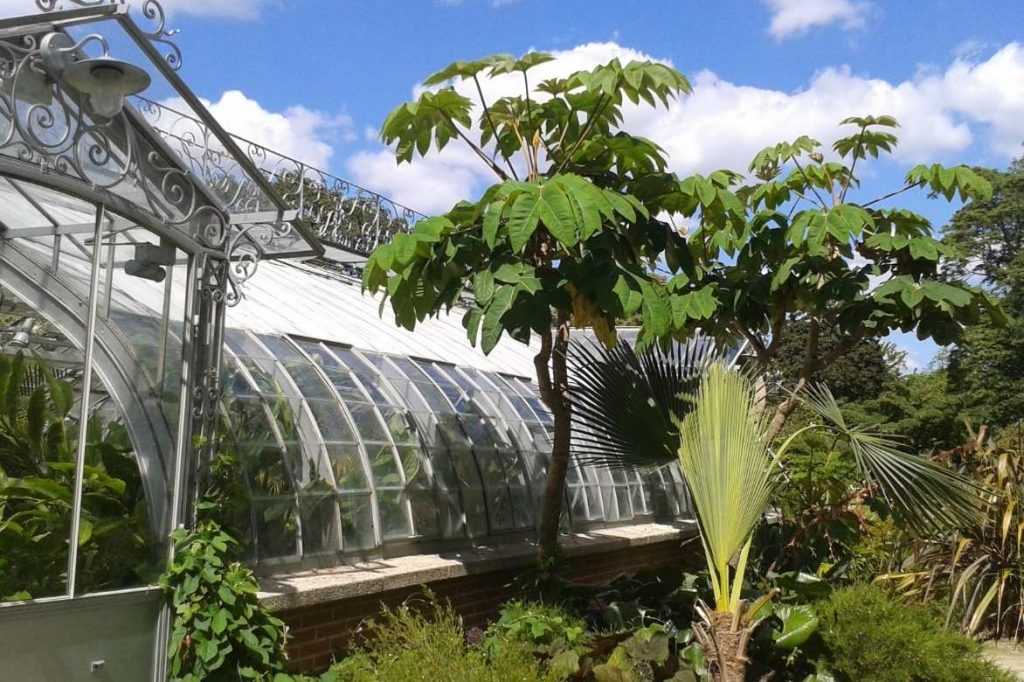
Tetrapanax at the botanical garden of Nantes (©Gwenaëlle David)
Description and Botany
Botanical data
- Latin name Tetrapanax papyrifera
- Family Araliaceae
- Common name Rice paper tree
- Flowering Summer to autumn
- Height 1.5 m to 6 m
- Sun exposure partial shade, non-burning sun
- Soil type any fresh, well-drained soil
- Hardiness moderate (-10 to -15°C)
The Tetrapanax papyrifera is a bush or small tree from the Araliaceae family, alongside Aralia, Ivy, and Schefflera. Its botanical name has evolved, and several references have been associated with it, including Aralia mairei, Aralia papyrifera, Didymopanax papyriferus, Echinopanax papyriferus, and Fatsia papyrifera.
Native to southern China, Taiwan, and the Japanese Ryukyu Islands, Tetrapanax grows spontaneously on the slopes of mixed forests, at altitudes between 100 and 2800 m, as well as in subtropical forests.
Its genus name comes from the Greek ‘tetra’, referring to the four stamens of its flowers, and from the Latin ‘panax’ (itself derived from the Greek ‘panakeia’), meaning ‘that heals all’. Panax is also the genus name for Ginseng, with which it shares a certain resemblance.
There is only one species, T. papyrifera (or T. papyrifer), with the name papyrifera referring to its pith, used in Asia to produce the famous rice paper with which food is sometimes wrapped, a characteristic that has earned it the common name Rice paper tree. This pith is also said to have medicinal properties, being both antipyretic (reducing fever), diuretic, sedative, and vermifuge.
Capable of growing up to 6 m tall (or even more) in its native habitat, this exotic-looking bush typically reaches between 1.5 m and 4 m in our latitudes, depending on growing conditions. Its spread can also reach 2 to 4 meters. With a rapid growth rate, Tetrapanax is primarily cultivated for its extremely decorative palmate foliage that has an exotic appearance. The bush develops a sparsely branched trunk topped with long petioles measuring 50 cm to over 1 m, bearing immense leaves. These leaves, arranged in a fan shape, are compound and can be up to 1 m wide. Cut into numerous lobes (5 to 11), they give the plant a particularly graphic appearance. Bright green and glossy on top, their underside is felted. The young shoots, light brown to silvery, are pubescent. The fine hairs on the leaves can, in some sensitive individuals and with prolonged contact, cause respiratory irritations.
Between late summer and autumn, and if the climate is favourable, the bush produces long panicles of small globose pom-poms, made up of tiny melliferous flowers with 4 petals and 4 stamens, cream white. Hermaphroditic, the plant then produces small round dark purple fruits at maturity, known as drupes.
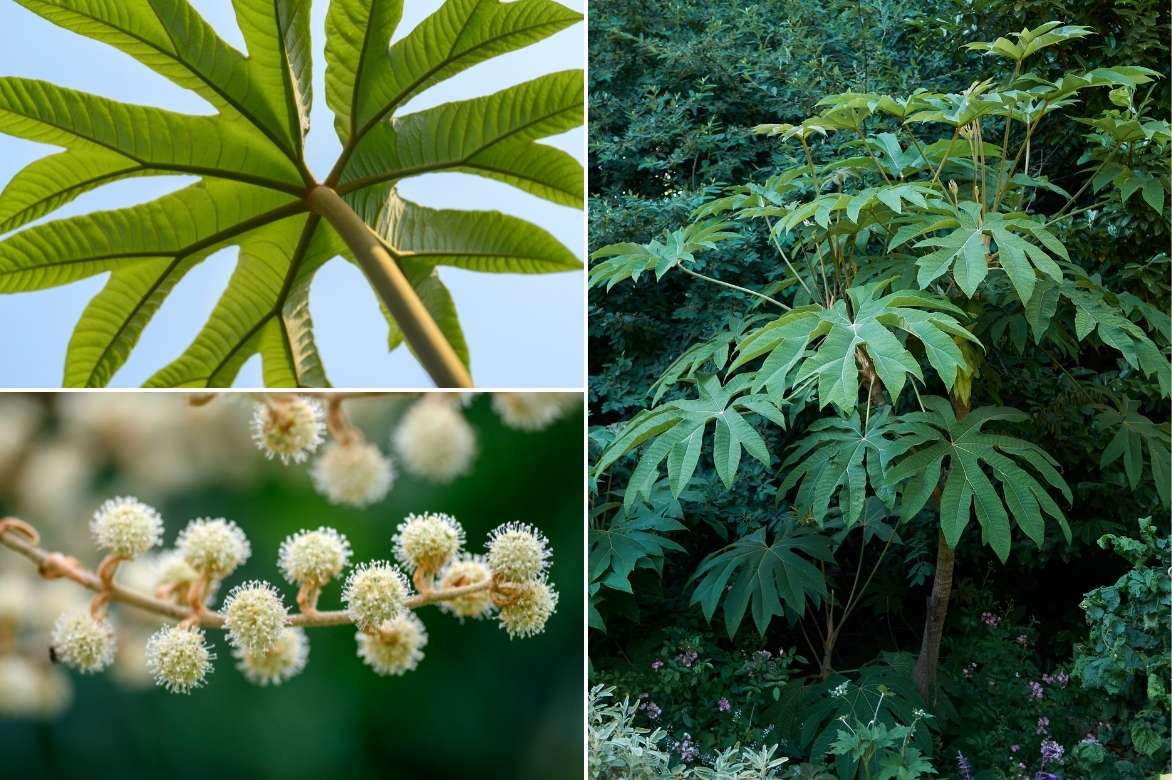
Foliage, flowering, and habit of Tetrapanax
While the genus contains only one species, several horticultural varieties have emerged. For instance, Tetrapanax papyrifera ‘Variegata’ features variegated foliage in different shades of green and cream. Tetrapanax ‘Rex’ and ‘Steroidal Giant’ (very similar) display strongly veined and particularly cut foliage, reminiscent of the sharp claws of the dinosaur of the same name, the T-Rex. ‘Empress’ is slightly more bushy and spreads a bit less than the type.
Exuberant, the Rice paper tree develops on roots that readily produce suckers, sometimes quite far from the base, especially if these roots are damaged. “New” subjects are then produced. If left in place, they can form clumps, but this is also an opportunity to take these suckers to propagate the plant. In certain regions of the globe (Hawaii, Australia, New Caledonia, Réunion), under a warm and humid climate, Tetrapanax can become invasive. This behaviour is less pronounced in our metropolitan climate, and installing a root barrier can ensure control in all cases. If you do not wish to see new plants emerge, remove the young suckers as soon as they appear.
The Tetrapanax enjoys both warm and humid conditions. Depending on the region, it can be placed in full sun or partial shade, while avoiding exposure to burning rays that can scorch its foliage. Windy exposures are also unsuitable, as its leaves may tear, especially if they rub against other woody plants. The ideal situation is a semi-shaded and sheltered exposure, benefiting from some sun in the early or late part of the day.
Moderately hardy, its leaves are destroyed by frost at -5°C, but the plant can withstand minimum temperatures of around -10°C to -15°C, and it can then regrow from the stump. The ‘Rex’ variety (or ‘Steroidal Giant’) offers better hardiness than the type. In mild climates, Tetrapanax remains evergreen and retains its foliage throughout winter. In these conditions, its trunk thickens and can reach 10 cm in diameter, while continuing to rise.
Any type of rich, deep soil that is well-fresh in season but properly drained in winter suits it.
Tolerant of sea spray, it can be suitable for seaside gardens with high humidity. It also finds its place in Asian-inspired gardens, creating exotic and lush atmospheres, and its bold graphic form makes it a bush for modern and contemporary landscaping. Growing in a large pot poses no problem, allowing it to be placed on a terrace or balcony, where its original look never goes unnoticed.
Very easy to cultivate, Tetrapanax is resistant to diseases and requires almost no maintenance. It is therefore a low-maintenance bush that one plants and admires.
Read also
How to design a tropical garden?Different species
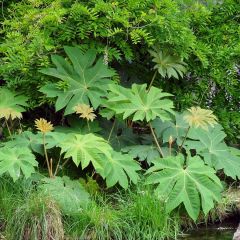
Tetrapanax papyrifera Rex - Chinese rice-paper Plant
- Flowering time November, December
- Height at maturity 2,50 m
Discover other Tetrapanax
View all →Available in 3 sizes
Planting
Where to Plant?
Tetrapanax papyrifera thrives best in deep, rich, and fertile soil. A good summer humidity and a cool soil allow it to develop impressively large leaves. However, ensure that water does not stagnate at its base in winter, as this may reduce its hardiness or cause its roots to rot.
Although it enjoys warm environments, avoid placing it in full sun, especially during the scorching midday rays. Partial shade suits it perfectly, but it can also grow in darker areas of the garden.
Wind-sensitive, provide it with a sheltered location.
You can plant it in the ground in a patio or garden, alongside bushes and perennials, as a standalone, or even in a pot on a terrace or balcony.
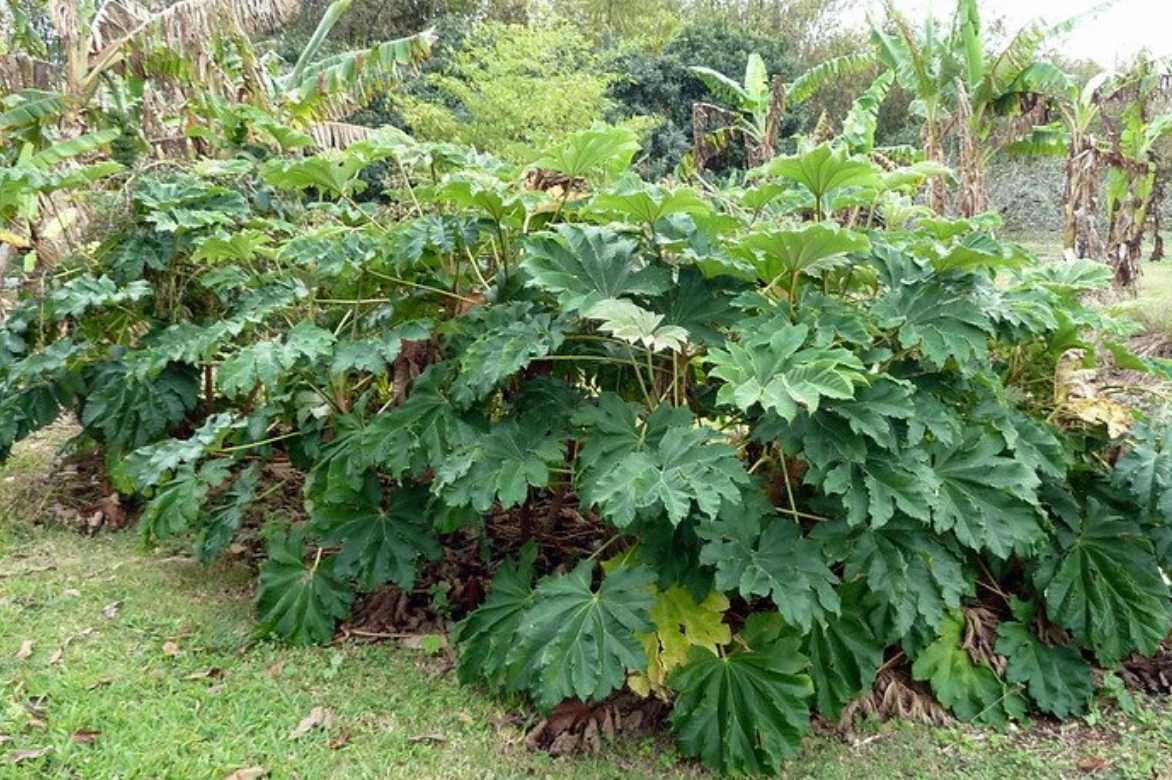
Tetrapanax (© Wendy Cutler)
When to Plant?
How to Plant?
Planting in the Ground
- Soak the root ball in a large volume of water to thoroughly moisten the substrate.
- In the meantime, dig a hole about three times the size of the pot, and loosen the soil well.
- Incorporate potting soil into your soil, and add coarse sand if it is heavy. The mixture should be airy and loose. Add one or two shovelfuls of compost depending on the size of the hole, two handfuls of slow-release fertiliser (such as crushed horn), and mix everything together.
- Remove your plant from its pot and position it in the centre.
- Fill in with your mixture and lightly firm it at the base.
- Water generously.
- Mulch to a depth of about 5 cm, and widely around the base. Preferably use an organic mulch (ramial chipped wood, fallen leaves, buckwheat or cocoa husks, lin flakes…)
Ensure that the soil remains cool during the season, and do not hesitate to water regularly during the first two years in case of low rainfall.
Planting in a Pot
- Choose a pot larger than the original container.
- Ensure that there is a drainage hole at the bottom of the pot, then place a drainage layer of about ten centimetres (clay balls, gravel…)
- Soak your plant in a large volume of water to saturate the substrate.
- Prepare a rich and draining mixture, consisting for example of good potting soil (2/3) and coarse sand (1/3). Add one to two handfuls of compost and a handful of slow-release fertiliser, such as crushed horn.
- Pour your mixture into the pot, leaving space to place your plant in the centre.
- Fill in with the remaining mixture, lightly firm it, and water thoroughly.
- Mulch with the material of your choice, organic or mineral, depending on your landscaping style.
Read also
Large-leaved shrubs and treesMaintenance and Care
The Tetrapanax is a low-maintenance plant.
In the ground
- Ensure the base remains moist during the season, and water in case of high heat and insufficient rainfall.
- Regularly check the mulch, and replenish if necessary.
- Cut off damaged or dried leaves when they become unsightly.
- You can fertilise your bush with a nitrogen-rich fertiliser twice a year (early spring and early autumn).
- In case of severe winter cold, you can protect the trunk by wrapping it in fleece, possibly filled with straw.
In a pot
- Provide your Tetrapanax with a larger pot at least every 2 years during its early years. For example, if you planted it in a container of 10 to 15 litres, move it to a pot of 35 to 45 litres in the second year, so that its running root system has space to develop. The larger your pot, the more generous your plant will be.
- In a pot, the soil dries out more quickly, so it is essential not to let it completely dehydrate. Daily watering may be necessary in summer, preferably in the evening.
- To improve air humidity, you can fill a saucer with clay balls soaked in water. Then place your pot on this bed. If the air is very dry, daily misting of the foliage is a good option.
- In winter, if possible, place your pot in a sunny position. You can also wrap the trunk in fleece to increase its resistance in case of severe frost, or bring the pot indoors to a frost-free, airy, and bright location.
- At the beginning of spring, perform a top dressing of the pot. This operation involves removing the top few centimetres of soil and replacing it with fresh, rich substrate. Take the opportunity to add compost or organic fertiliser.
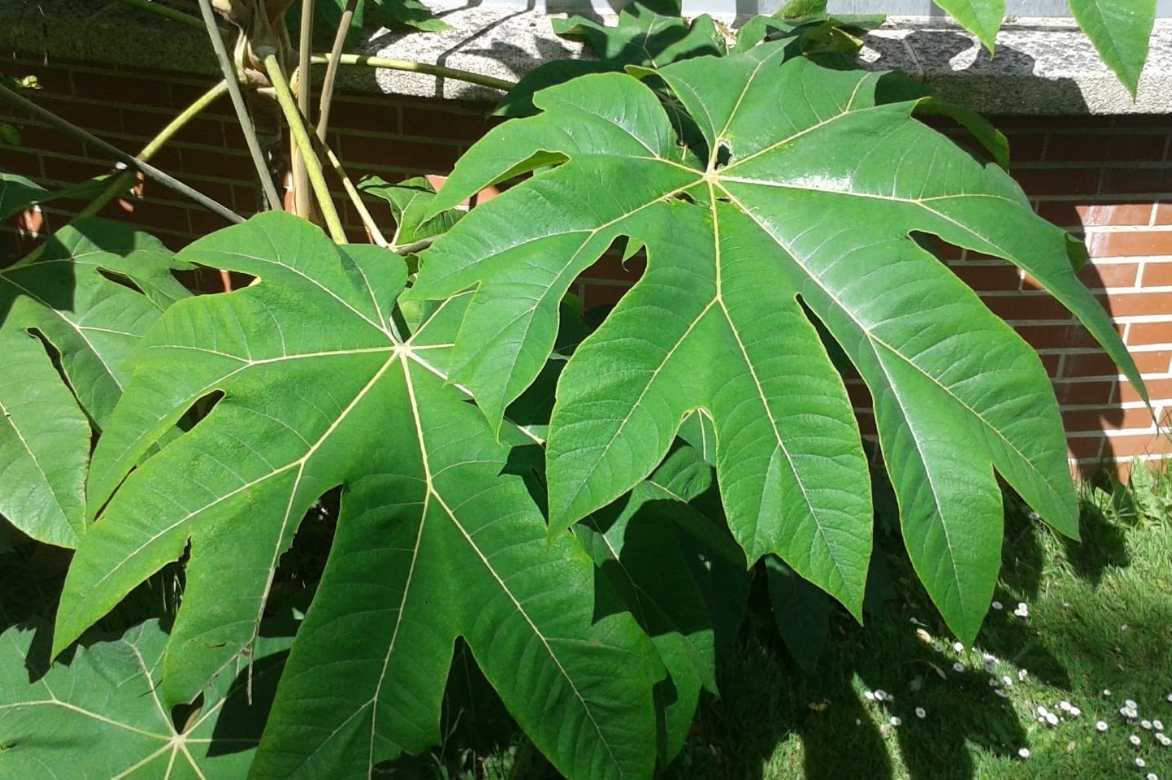
The impressive foliage of the rice paper tree (© Gwenaëlle David)
Multiplication
Tetrapanax multiplies by taking suckers, root cuttings, or sowing.
Taking suckers
Tetrapanax has a running root system and regularly produces suckers around the main plant. The simplest method is to take these suckers. Proceed when the plant is in its growth period (spring, summer).
- Using a sharp spade, take a sucker, ensuring to keep as many roots as possible.
- Remove all lower leaves, leaving just one or two at the top.
- Plant immediately in a pot large enough for the root system to develop.
- Water and store in partial shade.
- Keep the substrate moist, and ensure the young plant is not exposed to severe cold during winter.
- Replant in the garden the following spring.
Root cuttings
Root cuttings is another effective method. Proceed in early spring or autumn.
- Collect roots approximately the diameter of a large pen, and cut them into sections about 7 cm long. To identify the direction for planting, cut the upper part (towards the mother plant) horizontally, and the lower part (towards the tip of the roots) at an angle.
- Prepare a very light potting mix of special sowing and cutting type, or mix a standard potting soil with sand or, even better, perlite or vermiculite.
- In a large pot, insert your root sections a few centimetres apart, pushing them vertically into the substrate up to two-thirds. Ensure you respect the direction in which you insert your cuttings (angled part downwards).
- Water and cover with a thin layer of small gravel.
- Place your cuttings in a bright, warm location.
- Keep moist until the first leaves appear.
- When new leaves have started to develop well, repot your cuttings into individual pots, and monitor watering.
- Plant permanently in the desired location the following spring.
Sowing
You can also attempt to multiply your bush by sowing.
Seeds are ready to be sown towards the end of autumn or the beginning of winter, when they have reached ripeness. As their seed viability is quite short, do not wait too long to use them.
- Sow the seeds in individual pots, at a depth equal to their diameter. Use a light potting mix, of the ‘Special Sowing’ type.
- Water gently and keep warm.
- Keep the substrate moist to the touch.
- When the young plants produce their first true leaves, repot them into individual pots.
- Replant in the final location as soon as the following spring, once the last frost risks have passed.
Associate Tetrapanax in the garden
The Tetrapanax is a bush appreciated by enthusiasts of lush gardens with a tropical look. Its large, dissected leaves quickly transform a garden into a small jungle from the ends of the earth.
- In this context, it pairs wonderfully with the Japanese Aralia, which also has decorative foliage that ignites in autumn. With leaves that closely resemble those of the Tetrapanax, but with a more compact habit and slower growth, the Fatsia enhances the tropical undergrowth atmosphere, and the green leaves splashed with cream of a variety like ‘Spider’s Web’ are particularly luminous in low-light areas. Of course, palms like the hardy Hemp Palm or bananas with broad leaves fit perfectly alongside the Rice Paper Tree. You can also contrast its oversized foliage with that of a no less exuberant Gunnera. To play with the shapes of the foliage, complement with Rodgersias, Colocasias, or ferns, including the sculptural Dicksonia antarctica, and add a splash of colour with Begonia grandis, whose stems, flowers, and foliage take on shades of pink to purple.
- Its origins make the Tetrapanax suitable for Japanese-style garden designs, where it can coexist with bamboos, rhododendrons and azaleas. Also essential are the Japanese Maples, with their sumptuous autumn hues. Nandina, Pieris and Camellias complement the ensemble beautifully, as do the Japanese Anemones with their late flowering. Finally, low perennials such as Hosta with lush foliage or Hakonechloa, graceful and flowing, form carpets that serve as a backdrop for their neighbours.
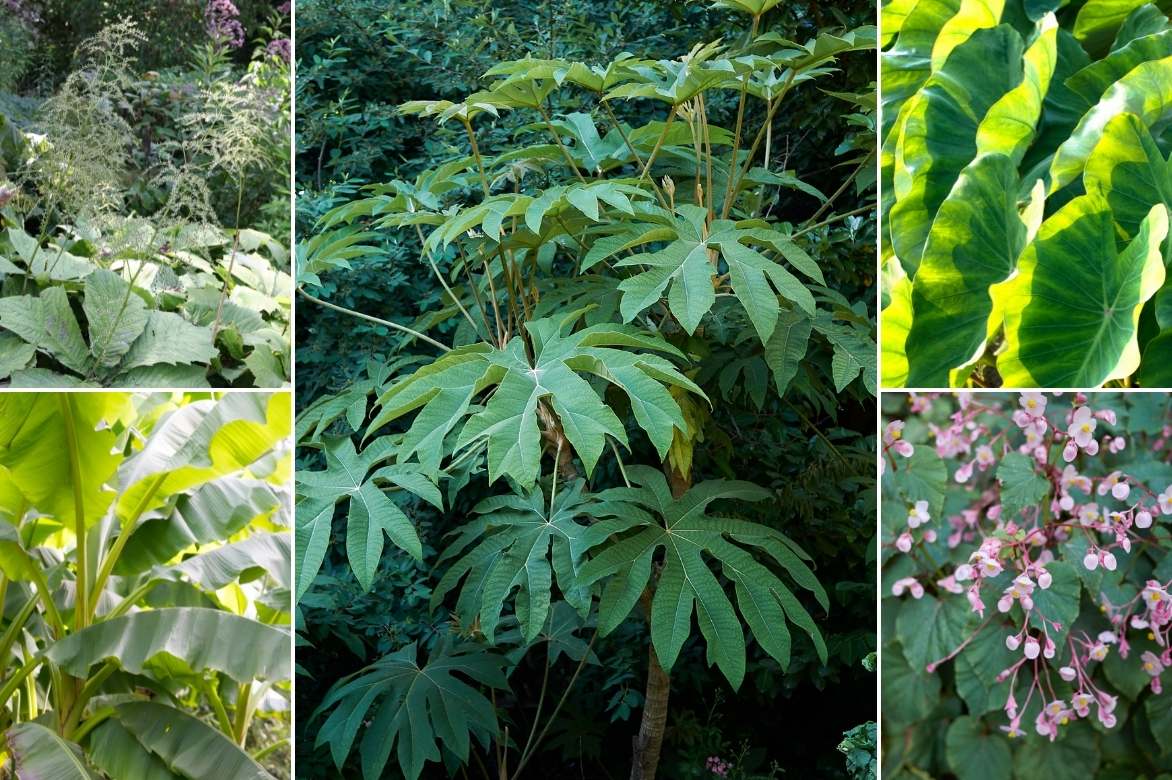 Jungle effect with a Tetrapanax surrounded by Rodgersia podophylla, a banana plant, Colocasias, and Begonia grandis
Jungle effect with a Tetrapanax surrounded by Rodgersia podophylla, a banana plant, Colocasias, and Begonia grandis
- Grown in large containers suited to its development, the Tetrapanax also makes its way onto terraces, patios, or balconies. Enhance its exotic look by pairing it (in separate pots) with shade-loving plants with striking foliage that also catch the eye. Install a Dryopteris erythrosora, a fern whose persistent, finely cut fronds emerge copper-orange in spring. In mild regions, or if you can winter it, the purple foliage of a Red Abyssinian Banana enriches the colour palette. Hardy only down to -5°C, prefer the Japanese Banana, which can endure around -15°C, but whose foliage remains green. Also consider bamboos. Planted in pots, even running types can be easily controlled. By cutting the lower branches on the lower third, you highlight the black canes of a Phyllostachys nigra, the golden yellow of the variety ‘Aureocaulis’, or the steel blue of the Fargesia ‘Blue Dragon’. A few Ophiopogon planiscapus ‘Nigrescens’ with black foliage can serve as groundcover, and if you’re looking for blooms, consider ornamental ginger, whose fragrant clusters in warm hues unfold between summer and autumn.
Useful resources
- The Tetrapanax is available in our online nursery.
- Discover 5 ideas for pairing Tetrapanax
- Olivier and Michael present the Tetrapanax in context in our video.
- Discover our tips for designing an exotic and tropical garden.
- What plants for an exotic balcony? Check out our selection!
- Subscribe!
- Contents
































Comments